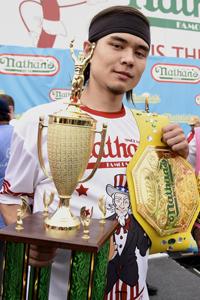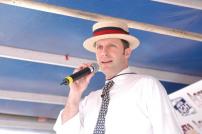
Major League Eating (MLE) is the world body that oversees professional eating contests. The organization, which
Sports Destination Management: Competitive eating as a marketable event has been on destinations’ radar for a while but what is the history of the sport itself?
Richard Shea: Realistically, it has been around since the beginning of man. Probably, 30,000 years ago, a bunch of cavemen were sitting around and some prehistoric animal walked by and someone had the idea of a competitive eating event. But if you think about actual events, you probably have images of things like harvest festivals where there were cherry pie-eating contests and so on. I would say it’s rooted in large part in the United States in those festivals from years ago.
SDM: When was MLE formed?
Shea: We developed our league in the late 1990s and started sanctioning events in 1998. We realized there were various competitive eating contests but there were no standards, no archives and no records. We decided to develop a league to maintain the sport, its safety and its integrity. We keep rankings of the most active and best
SDM: What are some of the events you put on?
Shea: We have major events like the Buffalo wings contest in New York, oyster eating in New Orleans and of course, the Nathan’s Hot Dog Eating Contest, which we’ve been doing for 13 or 14 years. It can draw 35,000 people. Sometimes, there are standalone events and sometimes, you might get hired by a town or a park and rec department or a restaurant or a food company and they’re very interested in having a fun event that is going to be a bullet point on their program for a festival or another large event.
SDM: It doesn’t take any specific venue, then.
Shea: One of the reasons I credit our ability to sustain and grow is the fact that the events are scalable. We can do them on a small or a large level, in front of 200 people or in front of 50,000, and we do both all the time. The production aspect is simple: you need to supply your prizes, tables, a sound system, branding, your food and an EMT. The event is not cumbersome at all. For instance, if you are holding it before a concert or another big sports event, it can be broken down quickly. As an example, we’ll be holding a gumbo-eating event in conjunction with the LSU/Alabama game. It will be set up like a tailgate party and we’ll have 5,000 pounds of gumbo.
SDM: Are there any economic impact figures for the sport?
Shea: We don’t track gate information. If we’re doing an event as part of a larger sports event, such as something NASCAR-related, for example, those would be their figures. Our bigger impact is the publicity. Our sponsors get good P.R. and the crowd is entertained. For us, it’s about moving the needle with the media and entertaining an audience.
SDM: Is there a demographic for competitive eating, particularly for the spectators?
Shea: A lot of people think that to follow competitive eating, you must be a teen or in your young twenties but it’s not that defined. I think there are more males who are more conversant in the stats and the stars of the sport. The sport is much less of a curiosity than it used to be; people recognize it.
SDM: If someone wants to host an event, where do they start?
Shea: We actually developed a document to send to people. They can contact us by using our website.
SDM: Do you have to look for sponsors for events, or do they find you?
 Shea: Markets come looking for us these days.
Shea: Markets come looking for us these days.
SDM: Was there ever any one moment when you, as MLE event owners, realized you’d made it?
Shea: Early on, there were many moments like that. Years and years ago, David Letterman had me on the show with John "Crazy Legs" Conti (primer for the uninitiated: Crazy Legs is a rock star in competitive eating) and not long after that, we were on the Howard Stern show. There is a picture I have of the Obama family actually watching the Nathan’s Fourth of July Hot Dog Eating Competition when they were all out on the road together. There are so many things I consider highlights – international figures, references in pop culture.
The funny thing is, back when we started this, George and I (Editor’s note: George Shea is Richard’s brother, and co-founder of MLE) would be going to malls in places like Fort Lauderdale and we had to pull people out of our audience: ‘You, sir! You look like a good American. Want to represent your city in this contest?’ And here would be this guy sitting down and trying competitive eating, even though all he’d come into the mall for was a pair of sneakers. But then he would get on the news. And that’s how it started. We really had to be carnival barkers.

